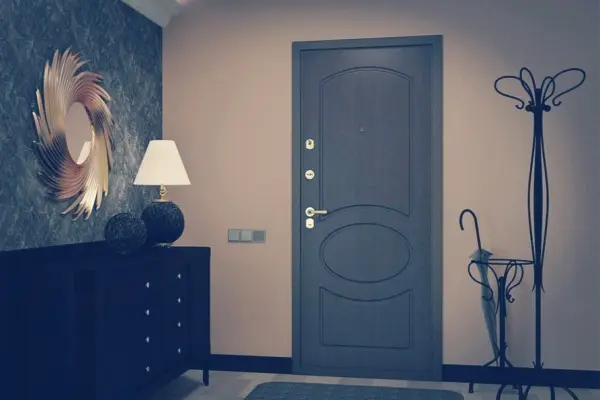Why do some homes feel spacious while others feel cramped even with the same square footage? Proper door size selection is the foundation of comfortable living and safety. In 2025, the average cost of redoing an incorrectly planned opening is $350, making the importance of accurate planning difficult to overestimate. Standard door opening sizes are regulated by international ISO 3810 and European DIN standards, which consider modern functionality and ergonomics needs.
Standard interior door width varies from 24" to 36" (610-914mm). Entrance door sizes according to international standards range from 32" to 40" (813-1016mm) — these aren't just numbers. It should be noted that interior door dimensions affect not only interior appearance but also occupant safety, similar to how artery width affects body circulation.
In practice, I often notice: incorrectly selected door leaf width creates numerous problems. From inability to move large furniture to violation of evacuation routes.
"It should be considered that proper door sizes with frame are not a luxury, but a necessity for comfortable living," notes architect Sarah Johnson, who has designed over 200 residential projects in her 15 years of practice.
International Door Width Standards
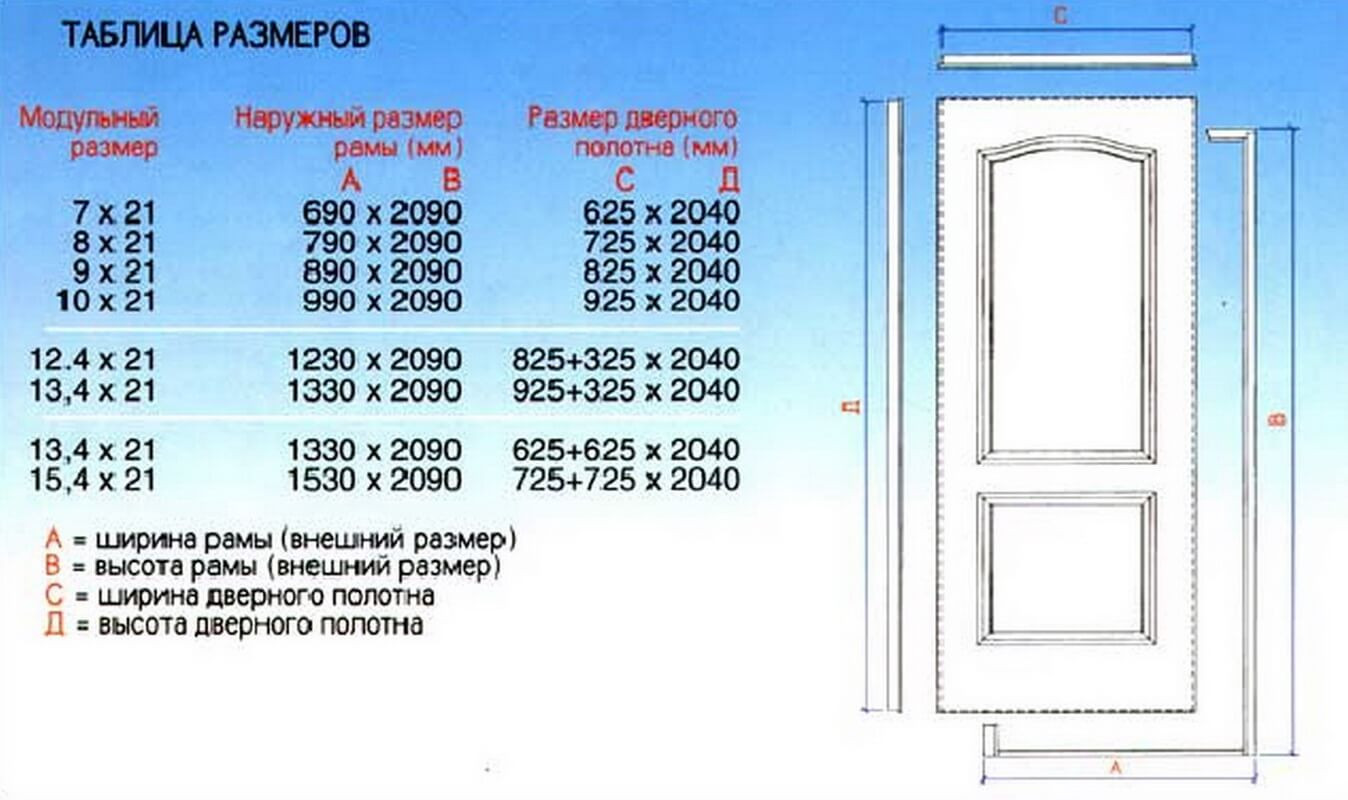 Door width standards internationally are regulated by ISO 3810 "Building construction — Modular coordination — Dimensions for building products." Clear rules. Standard door sizes include leaf widths of 24", 26", 28", 30", 32", and 36" (610, 660, 711, 762, 813, 914mm) at standard heights of 78", 80", or 84" (1981, 2032, 2134mm), ensuring universal application in various building types.
Door width standards internationally are regulated by ISO 3810 "Building construction — Modular coordination — Dimensions for building products." Clear rules. Standard door sizes include leaf widths of 24", 26", 28", 30", 32", and 36" (610, 660, 711, 762, 813, 914mm) at standard heights of 78", 80", or 84" (1981, 2032, 2134mm), ensuring universal application in various building types.
In one recent project, we encountered an interesting situation — a family ordered 30" wide doors from Europe, not knowing about differences in standards. European 762mm didn't fit under standard North American door openings of 32" (813mm). The redesign cost an additional $150. Thus, knowledge of local standards saves real money.
What sizes to choose for different rooms? Single doors have the following parameters:
- 24" (610mm) — for storage and utility rooms
- 26" (660mm) — for bathrooms
- 28" (711mm) — for kitchens and hallways
- 30" (762mm) — compromise option for small rooms
- 32" (813mm) — universal size for living rooms
- 36" (914mm) — for living rooms and offices
Considering structural features of modern apartments, the most popular sizes remain 28" and 32" (711 and 813mm). Proper width selection depends on the room's functional purpose.
European DIN Standards and Their Differences
European door standards DIN 18100-18102 offer a somewhat different approach to dimensions. Different measurement philosophy. Main sizes are 29", 30", 34", and 39" (735, 760, 860, 985mm) width at heights of 78" or 83" (1985 or 2110mm), reflecting European space planning traditions. The German DIN standards system serves as the foundation for many European norms and door width standards.
The Johnson family from Seattle decided to order German doors for their new home. When measuring openings, they discovered that the European standard 29" (735mm) perfectly suited their layout where every inch counts. Installation went smoothly, and quality exceeded expectations. "The precision of German sizes was amazing," noted the family head.
Non-standard door sizes according to European standards are manufactured in 10mm increments. This allows precise fitting to any opening. The international organization ISO/TC 162 coordinates standard door sizes globally. However, such solutions cost 25-30% more than standard ones — a compromise between individuality and economy.
Entrance Doors: Safety Requirements and Sizes
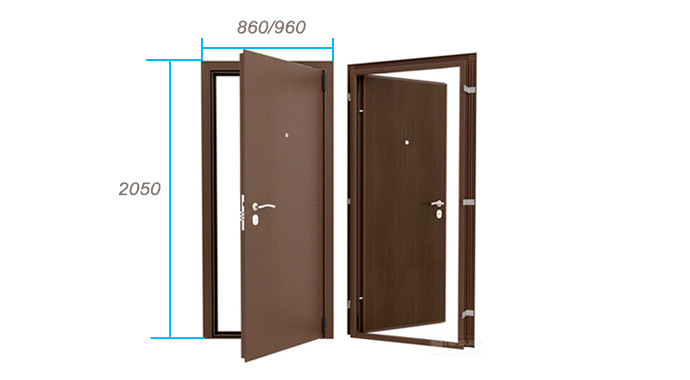 Entrance door sizes according to international standards (ISO 3810, IBC 2021) are determined by fire safety requirements according to NFPA 101. Minimum width is 32" (813mm). Not just a number — a matter of life and death in critical situations, especially when evacuating people from buildings of various heights.
Entrance door sizes according to international standards (ISO 3810, IBC 2021) are determined by fire safety requirements according to NFPA 101. Minimum width is 32" (813mm). Not just a number — a matter of life and death in critical situations, especially when evacuating people from buildings of various heights.
Standard door opening sizes for entrance structures vary by building type:
- 34" (864mm) — for apartments in older buildings
- 36" (914mm) — modern standard for new construction
- 48" (1219mm) — for commercial spaces and high-rise buildings
It's known that entrance door width affects evacuation capability — through a 36" (914mm) door opening under ideal conditions, up to 67 people can pass per minute, while through a 32" (813mm) opening — only 54 people. According to industry experts, optimal width for private homes is 36" (914mm), ensuring comfortable passage with large items. It should be considered that calculation accounts for not only throughput capacity but also psychological comfort of residents.
Important entrance door requirements include fire resistance class of 20 minutes for residential buildings and 60 minutes for public buildings, affecting construction and, accordingly, door leaf thickness.
Practical Aspects of Measuring and Installation
Door opening measurement requires a professional approach. Mistakes are expensive. Standard interior door leaf thickness is 1⅜" to 1¾" (35-44mm), entrance doors — 2" to 3⅛" (50-80mm), directly affecting door frame width and opening dimensions.
In practice working with private clients, I often encounter the situation: the client measures the opening "by eye" and orders a door based on the old leaf size. The result is predictable — additional fitting costs, stress, and time. Installation gap between frame and wall should be ⅝" to ¾" (15-20mm) on each side, otherwise quality installation is impossible.
Before taking measurements, it's important to consider the following factors:
| Room Type | Recommended Width | Door Opening Height | Features |
|---|---|---|---|
| Storage | 24" (610mm) | 80" (2032mm) | Minimum dimensions |
| Bathroom | 26" (660mm) | 80" (2032mm) | Standard dimensions |
| Kitchen | 28"-32" (711-813mm) | 80" (2032mm) | Consider appliance transport |
| Bedroom | 32" (813mm) | 80" (2032mm) | Standard size |
| Living Room | 32"-36" (813-914mm) | 80" (2032mm) | High traffic |
| Entrance | 34"-36" (864-914mm) | 82" (2083mm) | Safety requirements |
This table will help determine optimal sizes for each room type considering functional requirements.
Standard door frame width is 2¾" to 4¾" (70-120mm). With wall thickness over 4¾" (120mm), door extensions will be needed — special strips to compensate for depth. Why do many forget about this? Door casings hide joint locations and give the structure a finished look, but their installation requires precise size calculations.
"Considering structural features of modern materials, proper measurement is 80% of installation success," notes master installer Mike Rodriguez with 20 years of experience.
Double Door Systems and Their Dimensions
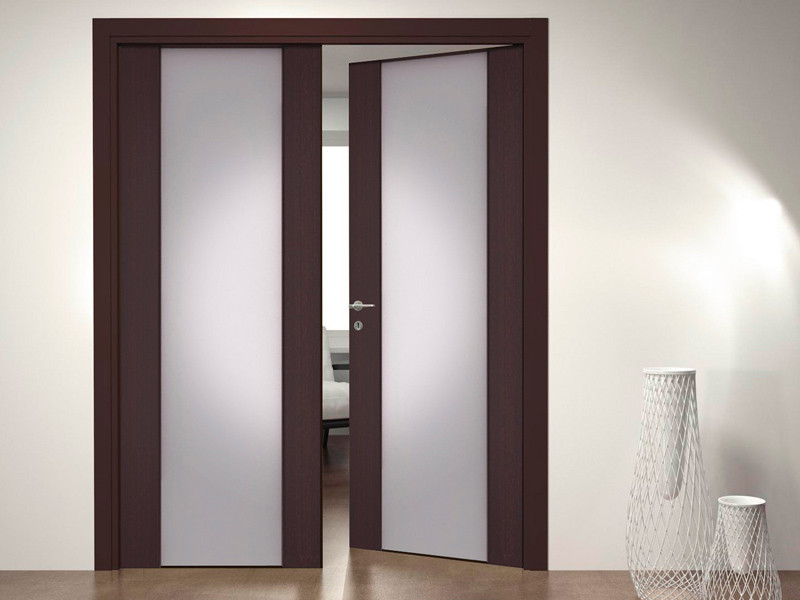 Double doors with width exceeding 48" (1219mm) are used in high-traffic areas. Impressive scale. Standard sizes are 48", 60", and 72" (1219, 1524, 1829mm), allowing creation of a ceremonial entrance to main home areas.
Double doors with width exceeding 48" (1219mm) are used in high-traffic areas. Impressive scale. Standard sizes are 48", 60", and 72" (1219, 1524, 1829mm), allowing creation of a ceremonial entrance to main home areas.
When choosing a double door system, it's important to consider specific parameters:
- Active leaf width (usually 24"-32"/610-813mm)
- Leaf ratio (symmetrical or asymmetrical)
- Presence of entrance door threshold
- Locking system
On one project last season, we installed 64" (1626mm) wide double doors in a 430 sq ft living room. The result exceeded expectations — the space visually increased and functionality grew. Thus, properly selected dimensions can dramatically change interior perception.
Cost of Non-Standard Door Solutions
Custom door manufacturing costs 30-50% more than standard ones. Installation of non-standard sized doors increases by $50-100 due to fitting complexity.
Structural opening for non-standard doors requires additional preparation. Expanding a door opening in a brick wall costs $200-300, in concrete — $300-500.
"It should be considered that savings on standard sizes can result in significant renovation costs," warns foreman Andrew Thompson.
Material Influence on Door Sizes
Door leaf material significantly affects final structure dimensions. Wood doors have standard thickness of 1⅜" to 1¾" (35-44mm), metal entrance doors — 2" to 3⅛" (50-80mm), and glass systems — ¼" to ½" (6-12mm) plus profile.
Main material characteristics are presented in the comparison table:
| Material | Leaf Thickness | Opening Impact | Features |
|---|---|---|---|
| Solid Wood | 1⅜"-1¾" (35-44mm) | Standard | Possible shrinkage |
| Metal | 2"-3⅛" (50-80mm) | +⅝"-1¼" (15-30mm) to width | Thermal expansion |
| Glass | ¼"-½" (6-12mm) | -¾"-1¼" (20-30mm) to width | Requires reinforced hardware |
| PVC | 1⅝"-2⅜" (40-60mm) | +¼"-⅜" (5-10mm) to width | Stable dimensions |
This information will help accurately calculate required opening sizes considering chosen material.
Accessibility Requirements
According to ADA Standards for Accessible Design, doors for people with disabilities must meet special requirements. Minimum passage width is 32" (813mm), and for entrance doors — 36" (914mm), ensuring free wheelchair movement.
Key accessibility requirements include:
- Door leaf width not less than 32" (813mm)
- Threshold height not more than 1" (25mm) or absence thereof
- Opening force not more than 8.5 lbf (40N)
- Handle height 32"-44" (813-1118mm) from floor
- Clear floor space before door not less than 48" (1219mm)
- Automatic closing time not less than 3 seconds
In practice working with public facilities, I often encounter situations where these standards are ignored. The result — building inaccessibility for 15% of the population, which is unacceptable in modern society and contradicts international accessibility standards.
Alternative Door Systems
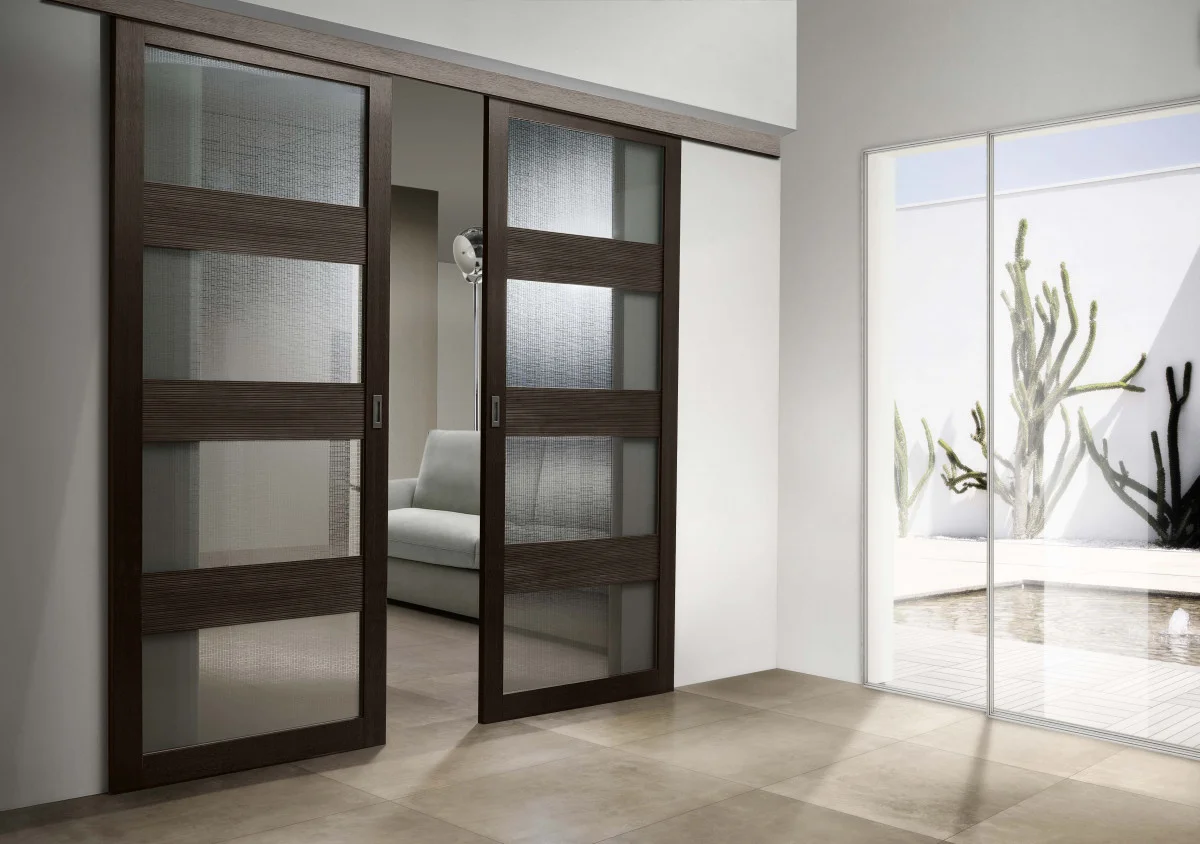 Sliding systems are becoming a popular alternative to swing doors. Space saving. Standard sliding leaf width is 24"-40" (610-1016mm) at heights of 78"-96" (2000-2400mm), but additional wall space for tracks must be considered.
Sliding systems are becoming a popular alternative to swing doors. Space saving. Standard sliding leaf width is 24"-40" (610-1016mm) at heights of 78"-96" (2000-2400mm), but additional wall space for tracks must be considered.
Folding accordion doors have a folded width of only 4"-6" (100-150mm). This is a real find for small spaces where every inch counts. Glass partitions with sliding elements visually expand space with profile width of only 2"-3⅛" (50-80mm) — an elegant solution for studio apartments.
Common Mistakes in Door Size Selection
Years of construction industry practice have revealed several critical mistakes leading to additional costs. Statistics are relentless. According to industry research, 35% of customers make measurement errors, costing an average of additional $200-500 — money that could have been spent on quality door hardware.
Main sizing mistakes require detailed analysis:
Incorrect Opening Measurement
Measuring only at one point without considering wall curvature — a classic beginner mistake. The proper approach involves measurements at three width points and two height points, choosing the smallest values.
Ignoring Finish Thickness
Measuring "bare" walls without considering plaster, tile, or panels can lead to disaster. Don't forget to add ¾"-2" (20-50mm) to wall thickness for finish, otherwise the door frame won't fit in the opening.
Not Considering Opening Direction
Ordering a door without specifying opening side leads to installation impossibility. Determine direction at the measurement stage — this saves time and stress for all process participants.
Economizing on Extensions
With wall thickness over 4" (100mm), extensions aren't luxury but necessity. Saving $30-50 on extensions can result in $300 opening renovation — simple math, but many ignore it.
"It should be considered that proper measurements are 80% of installation success, and one 3/16" (5mm) error can be costly," warns technical expert Victor Stevens with 20 years of interior door installation experience.
Step-by-Step Door Size Selection Algorithm
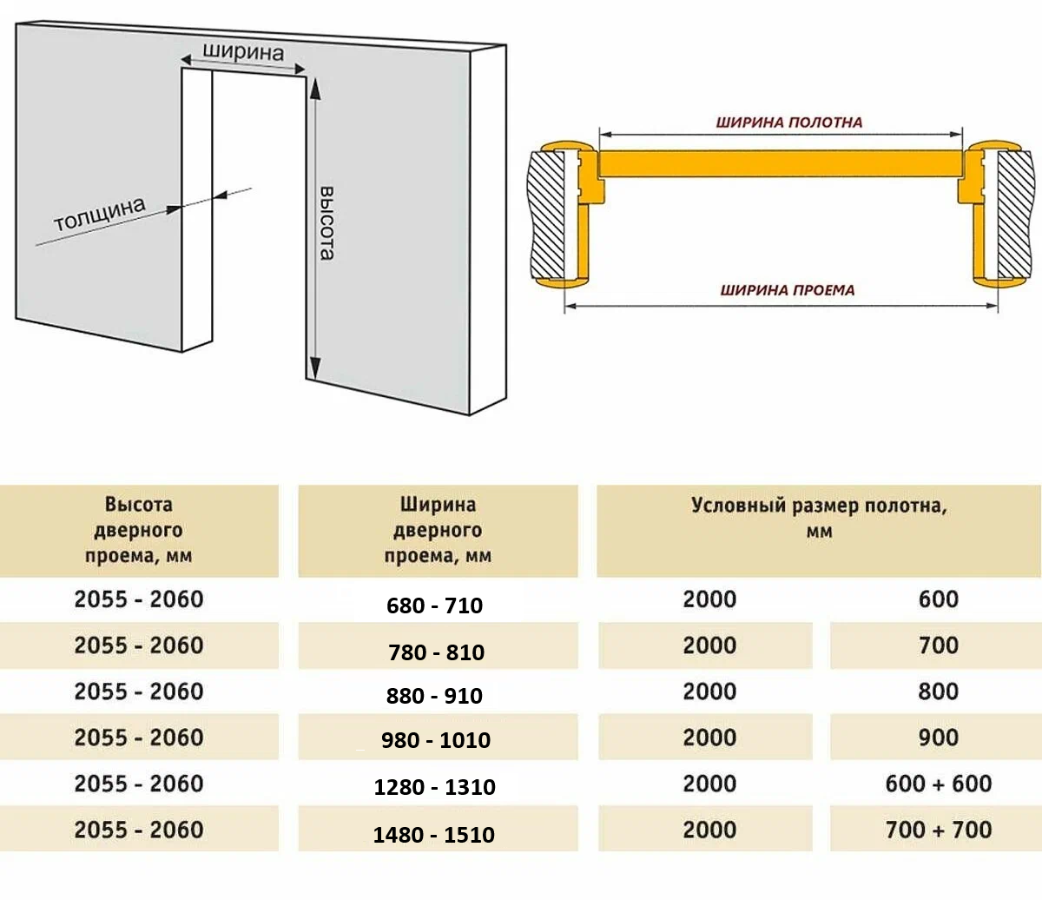 A systematic approach to door size selection helps avoid mistakes and additional costs. The algorithm consists of seven key stages.
A systematic approach to door size selection helps avoid mistakes and additional costs. The algorithm consists of seven key stages.
Stage 1. Determine room function
Choose room type and corresponding width: bathroom — 26" (660mm), kitchen — 28" (711mm), living rooms — 32" (813mm), living room — 32"-36" (813-914mm).
Stage 2. Measure opening
Measure width at three points (top, middle, bottom), height at two points (left, right). Record smallest values.
Stage 3. Check wall thickness
Measure thickness at six points (three on each side). Maximum value determines need for extensions.
Stage 4. Choose material
Consider material impact on dimensions: wood doors are standard, metal adds ⅝"-1¼" (15-30mm) to opening thickness.
Stage 5. Calculate including installation gaps
Add to leaf dimensions: frame width (2⅜"-3⅛"/60-80mm) plus installation gaps (¾"-1¼"/20-30mm).
Stage 6. Check standard compliance
Ensure compliance with safety and accessibility requirements (minimum 32"/813mm for entrance, 34"/864mm for accessible environment).
Stage 7. Final check
Compare calculations with manufacturer capabilities and project budget.
Practical Checklist for Door Measurement and Selection
This checklist helps avoid main door ordering mistakes and guarantees successful installation. Statistics show checklist use reduces errors by 85%.
Before measurement:
- All wall finishing work completed
- Old doors and casings removed
- Measuring tools prepared (tape measure, level)
- Room purpose determined
During measurement:
- Width measured at three points (top, middle, bottom)
- Height measured at two points (left and right)
- Wall thickness checked at six points
- Door opening direction determined
- Opening geometry checked with level
- All utilities in opening accounted for
During calculation:
- Minimum width and height values selected
- Installation gaps added (⅝"-¾"/15-20mm each side)
- Door frame width considered (2¾"-4¾"/70-120mm)
- Extension need calculated
- Safety standard compliance verified
Before ordering:
- Sizes compared with supplier capabilities
- Non-standard size costs clarified
- Manufacturing and delivery timelines agreed
- Manufacturer reputation verified
- Product warranty arranged
"I know from experience: those who spend an hour checking the checklist save a week on revisions and hundreds of dollars," notes foreman Andrew Smith with 25 years of experience.
Proper standard door size selection is an investment in comfort, safety, and durability of your home. Following international ISO and European DIN standards, professional measurement approach, and considering all technical nuances guarantee successful results for years to come. Modern installation technologies and quality door hardware allow implementation of any architectural solutions while meeting all safety and ergonomics requirements.
